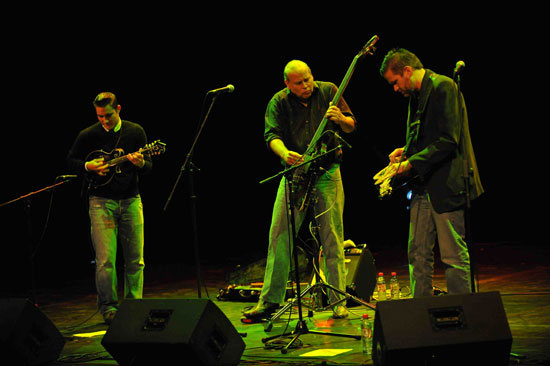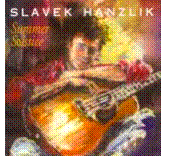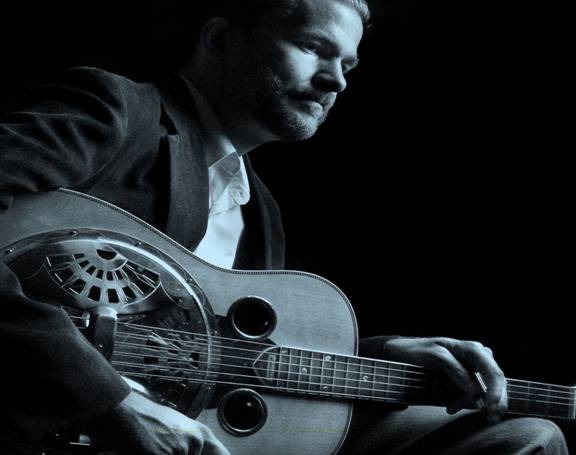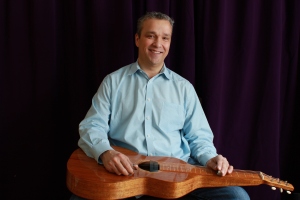Originally published at www.robanderlik.com in 2008
SJ: Your latest project – Three Ring Circle – is fantastic on so many levels. First of all, it’s great music; highly enjoyable to listen to and incredibly innovative. Unless I am mistaken this is the first mando-dobro-bass trio project ever, correct? How did this project come about? How did you go about writing and arranging the tunes?
RI: It came about pretty organically. Dave (Pomeroy) and I have been working in town together a lot; playing on other people’s records and we just hit it off. We started playing some music together, playing around town. Sometimes Dave would have his own gig; we started writing some tunes. We started looking for somebody else to pick with and I had met Andy (Leftwich) awhile back. I always thought he was a great player and I didn’t even know he played mandolin! I had only heard him play the fiddle. I heard him do some work with Ricky Skaggs and I don’t know, we just hit it off we’d wind up playing music together. So I told Dave “this guy’s great” we should get together. Then the three of us got together informally one night at a bluegrass festival in Nashville and it seemed like sparks were flying. Andy had this song that he’d written and started playing it and I started playing with him, Dave jumped in; we had these neat arrangement ideas that came together pretty quickly. So that’s how it got started…everything just fell into place.
SJ: Did the unique instrumentation force you to change your approach/technique to providing rhythmic support during mandolin solos?
RI: It’s actually been easier. Sometimes it can be a little bit challenging to play in a trio; there are only three of you and you have to keep it going; you can’t hide behind anything, so you really have to be up on your game. But in some ways it’s a lot easier because there are only three of us. I can hear the dobro better; I can hear everything a lot better. For me I feel as though I can get even more expressive. As far as rhythmically there is not much difference. I’m still doing a chop like I would in a bluegrass band. I don’t feel like I’ve changed rhythmic approach that much; it’s similar to playing in a bluegrass situation.
SJ: When did you realize that playing the dobro was going to be your day gig? Were there any special experiences or circumstances that led to that decision? Was it hard to break into the music scene when you first moved to Nashville?
RI: The first time I head Mike Auldridge first album it was a “lightening bolt” experience. I knew I had to learn to play the dobro. I just knew that I loved it…a lot! And I always knew that was that I wanted to do. When I got a little older living in California felt like an island, musically; at least for acoustic music. I would read about these great players – Tony Rice, J.D. Crowe, but they really didn’t come out there that much. Bluegrass artists at that point didn’t go out to California very often; it wasn’t expected. Now that I’ve played for living I know why the bands don’t get out there as much. So I thought really seriously about it but I didn’t know how to get from point A to point B, you know. So I just kept playing and working with as many people as I could. Then in 1990 Alison Krauss hired me to play on the Cox Family’s 3rd record for Rounder Records. I was friends with Ron Block who was in her band; he was also from California. So they flew me out here and we worked on the record all week and it was so much fun and the music was so great. That kind of did it for me. I was already playing full time at that point but I was not doing much because there was not much to do in California for bluegrass music. So that really tipped my decision to move to Nashville and got the ball rolling which led to me joining Blue Highway. We all met a couple of years after that.
SJ: You have played with such an impressive roster of artists over the years. What have been some of the highlights of those experiences for you? What effect have other musicians had on your own musical development?
RI: The first record I did with the Cox Family was an incredible experience. It was one of the first times where everyone, all the musicians were just great. You know when you’re out there farming around and you think your good, you think you know what you’re doing, but if you don’t get in the right environment you don’t know what you’re capable of. So I felt like that was the first time I’d been with musicians who could make me sound good. It’s a team effort. That was the first time I’d really played with all these great musicians – Ron Block, Barry Bales, and of course Alison Krauss. So it was like “hey this is fun, this is nice.” So that was a great experience. I’ve had some great stuff happen…in the last few years I’ve been playing the Earl Skruggs band. It just been incredible to get to know Earl and to work with him, he’s such a legend. And to find out what a great guy he is. Not only is he a really important musician but just to get to know him personally has meant a lot to me. I’ve also had the opportunity to work with Tony Rice in the last few years. I’m kind of a part-time member of the Tony Rice Unit. And same thing…I put Tony and Earl on the same level: they’re important to me; in a lot of ways more important than the dobro players I listen to. Not only is Tony a great singer and guitar player but as a producer he’s put out records that haven’t been beat in my opinion.
SJ: Like his record Manzanita for example? That record seems to have been a benchmark or standard for a lot of aspiring bluegrass musicians.
RI: Yes, Manzanita or Cold on the Shoulder and the Bluegrass Album Band records. He was a catalyst and also has a way of making people play better. He picks great material but he’s such an incredible supportive rhythm player that he brings the level up for everybody that plays with. And of course to work with Blue Highway has also been amazing. We’ve been together for over 12 years now; it’s been one of the best things that’s ever happened to me. For me coming from California, where I loved bluegrass but didn’t get to see it all the time…to get to work with these guys, who are from eastern Tennessee and western North Carolina where this music is from. And, these guys just do it better than anyone else. So to be able to hook up with the musicians of their caliber and have that be my main gig has been a great experience for me.
SJ: I am pretty confident everyone is familiar with the amazing range of work on your solo recordings, your work with Blue Highway and a long list of high profile recording artists such as Alison Krauss, Dolly Parton, Ricky Skaggs and so on…With that said, some folks may not be aware of the more obscure work you have done. For instance, your work with (Czech guitarist and former Chicagoan) Slavek Hanzlik on Summer Solstice and Fall of My Dreams– fantastic stuff with a stellar cast of musicians – Bela Fleck, Tim O’Brien, Stuart Duncan and Mark Schatz. Are there any more “obscure” projects that you are especially proud of that your fans may not be aware of?
RI: It’s funny you should mention Slavek’s records because I just heard then again. I was playing somewhere and they played Summer Solstice before the show. I had forgotten about that record. It’s a really nice record. Slavek writes great melodies and is a great player. That was probably one of the first things I did when I got to Nashville. It was great to work with people like Mark Schatz, Tim O’Brien and Stuart Duncan in the studio. I also did this record with Raul Malo (lead singer with The Mavericks) a couple of years ago called Nashville Acoustic Sessions. It was me and Dave Pomeroy and Pat Flynn and Raul. It was neat, just a three piece band backing up his vocals. When we were cutting the record it seemed loose and sort of out of control, nobody knew what was going on (laughs)! But when I got the record back I really like it. I thought everything sounded really good. Some really nice moments on that record… I really love the Cox Family records as well – (Everyone is Reaching Out for Someone, I Know Who Holds Tomorrow)
SJ: The first time I heard you was back around 1992/93 on the Tony Furtado record – Within Reach – playing the Beatles tune “I will” with Alison Krauss on vocals. Truth be known, I just assumed it was Jerry Douglas! That tone – big, round, full, and so-oooo in-tune! I seemed to me then that you were the first “new” guy to come along after Jerry had done so much to revolutionize the instrument. How do you trace your musical heritage as a dobro player and musician? Do you feel your style has evolved or changed since the time you first came on the music scene?
RI: I hope my style is always evolving and changing. That’s one of the things that I’ve always admired about Jerry Douglas playing. He has a style but he would always play differently depending on the situation he was in. I always thought he was an interesting musician because of that. He sounded different on each of his records but on other people’s records too. He never had this “here my three licks that I do” “this is my sound” approach. He was a great improviser and would play whatever fit the moment. So that is something that I have always strived for too. I’m always learning and trying to change. With the Three Ring Circle record I feel like I’m playing stuff that I’ve never played before, you know I’m getting sounds out my guitar that I haven’t got before. As far as the evolution of it when I started my goal was to sound like Mike Auldridge; that was all I wanted to do. And then I got into Jerry Douglas, Josh Graves and Brother Oswald, those are my four main influences. As I got older I listed to those guys so much, absorbed a lot of it and started to wonder, “what do I sound like?” It felt funny to play a Jerry Douglas lick. I felt like I was stealing every time I played an Auldridge lick or Josh Graves and I really got curious about “what do I sound like” or “how would I play this.” And it helped me to make that switch. A lot of people don’t do it. They might get to where they can play like Jerry and they stop right there. That’s o.k. but I was always curious about what I sounded like and it’s been a continual search.
SJ: As a Christian and as a musician I am especially grateful to you for your arrangements of traditional hymns on the dobro. Your contributions of tunes like “How Great Thou Art” and “Be Thou My Vision” have inspired me not only to learn those tunes that you have arranged but also to try my own hand at arranging hymns. Can you share any insight as to how you pick tunes or how you go about adapting them to the dobro? Does the tuning make a big difference in the arrangement?
RI: I do 99% of my stuff is in G tuning. I think I heard How Great Thou Art when I was sitting in church one time. It’s a standard tune but I didn’t grow up in church so a lot of this music was new to me. So as I recall I heard it in church and thought to myself this would sound really good on the dobro.” It was the same with Be Thou My Vision. I think that’s where I got that from.
SJ: So you took your cue from the vocal melody and made up your own arrangement?
RI: Yes. I listen to singers a lot and think of the dobro as a really vocal instrument. The key of G is nice because you have all those open string possibilities which help direct the song. When you play dobro its like playing guitar with one finger; it’s hard to get those big chord changes and bass notes, so the key of G works really well. Be Thou My Vision is in C. I’m not really sure why I played it there. It starts out over this C add 9 chord which has this ethereal, rippling water sound you know? I’m a big fan of the melody. I went through big Chet Atkins phase, listened to a lot of his records. He can just play the melody and sound great with hardly embellishing at all. It’s fun to take a great melody and work up an arrangement; it’s a fun thing to do and the dobro is good for that.
SJ: Let’s talk about gear for a moment. Tell us about your resonator guitars.
RI: I started playing Scheerhorns in 1990; I’ve got # 8. Sally Van Meter is a good friend of mine and we were both living in California at that time. She got a guitar from Tim. I played her guitar and went “wow, I’ve got to get one of these.” It was like night and day compared to my guitar which at that time was the first dobro I ever bought – a 1979 OMI Model 60D Dobro. I called Tim the next day and placed my order for one of his guitars. I just loved it – it sounded great and was so beautiful. I probably played that guitar for 5-6 guitars and I dropped it during a photo shoot or something happened where it wasn’t giving me what I wanted. Tim had a rosewood guitar that really liked so I played that for a couple of years and then he made me a large body (L Body) version of that guitar which I play to this day. So, when I find a better guitar I’ll play it, but I haven’t yet. There’s something about that guitar that gives me a sound that I like. I think the Rosewood gives it a nice warm tone. Tim had 2 or 3 guitars when he brought those to me in 1998. I played all three of them but the one I picked was the one that he had made specifically for me. It just had everything that I wanted.
SJ: What does your “live” rig consist of? What kind of microphone and/or pickup and preamp do you use? Do you like to use any spatial effects such as reverb or delay when you play live?
RI: 99% of the time I use my own microphone which is an AKG C1000. No big deal. It’s not expensive. It just seems to fit my guitar and gets a really warm tone. It seems like I’m always leaning toward a warm sound. I don’t like a really high end-y guitar. I prefer something big and fat sounding. I think this microphone really matches my guitar well. I like it because it’s a condenser microphone but it doesn’t feedback easily. When you’re playing festivals and have a 3 minute set-up you want something you throw up there and go to work without it ringing. You can’t use a really nice studio microphone because it would feed back too much. So the C1000 is the right balance of good tone with being prone to feedback. I also have a Schertler Basik pickup in my guitar which I use if it’s a loud live situation where there’s drums, electric bass or electric guitar, but I try to use a microphone whenever I can because I get the best tone that way.
SJ: Tell us about the new Wechter/Scheerhorn Rob Ickes model? How did this guitar come about; how is it different than the other Wechter/Scheerhorn models?
RI: Tim Scheerhorn designed it. Tim and Abe Wechter have gone into business together and are making plywood dobros. So the Rob Ickes model is exactly like my guitar but made out of plywood and they are really sounding great. We sold out of the first run of 48 guitars in the first two months.
SJ: You’ve won IBMA Dobro Player of the Year 7 times now. You are the only person other than Jerry Douglas to win the award. As such, you are in a unique position to comment – what does the future of the dobro look like? Is the “dobro songbook” expanding to include new standards? How is the range of the instrument being expanded by today’s up and coming players?
RI: It’s tough to say… There are some really good young players coming down the pike right now. It seems like every time I turn around there’s another good dobro player coming up. I think that’s good. I think that is good for the future. I think there will be a really good generation of players coming up. As far as where it’s going – I just hope it gets more and more popular. It’s a great instrument. I guess I’m a little surprised that there aren’t even more people playing right now because people who are new to the instrument always freak out over it. But maybe that’s changing with the new generation of players coming up. You know, that’s what I love about the instrument I’ve made some solo records and I tried to take the instrument into new territory and see what it can do and I’m always impressed at how the tone of the instrument can work in a lot of different band contexts. So that’s something that interests me. What can this thing do? How far can I push it and still sound great? It’s interesting to me to work with jazz musicians or classical musicians or whatever.
SJ: Taking the instrument out of its native context of country or bluegrass music, for example?
RI: Exactly! There’s something that’s kind of freeing when you’re creating something new, like this trio with dobro, mandolin and bass. I don’t know if that’s ever been done before. It’s a very creative situation where it all sounds new so you feel really creative and productive in those situations. I think that’s why musicians do that – push the envelope, etc. I know some fans want you to stay and just do what you’ve always done, but if I did that I think I would get stale, you know?
SJ: I guess that tension will always be there – between tradition and adding to the songbook.
RI: Exactly! I’m not the first person to experience that or try that; I guess everyone goes through that. So I guess I’m impressed with what the instrument can get away with that and that’s an interesting part for me. As far as what I’m going to do on the instrument is keeping pushing the envelope and trying it in different music and different styles.
SJ: Sally Van Meter once told me that you had put in a lot of hours transcribing Robben Ford solos for the dobro. What’s the story behind your jazz projects – Slide City & What It Is? How/when did you decide to record those records? How did you go about arranging the tunes and instrumentation? Did those records present any special challenges compared to recording with traditional acoustic instruments?
RI: When I went to college I got introduced to a lot of jazz music, rock and blues. Players like Robben Ford, B.B. King, Larry Carlton and John Scofield made a big impression on me. I got really excited about it. It was like hearing Tony Rice for the first time, that level of intensity. I started wondering if some of this music would work on the dobro and found that some of it laid out very well. I don’t know why I did those jazz records. I think just listening to that music made a big influence on me and I thought it would be fun to put the dobro with drums, bass, piano and saxophone, you know? And I got these great players and we made records which I am really proud of. I feel like we got into some really good stuff. I didn’t want to sound like a bluegrass guy playing jazz songs. Sometimes bluegrass players will do that – take a jazz song but they’ll do it with a bluegrass band. I always wanted to take the dobro and put it in a jazz band. I thought it would sound a little smoother, a little more natural. That’s what I like about those records – you go “that’s a great jazz record” and then “oh, that’s a dobro” You think about that later. That’s what I like about those records. But I think just from listening to a lot of jazz and blues and rock colored my vision of what the dobro could do.
SJ: In addition to being a recording artist, you are also very well known as an instructor. I have a copy of your Homespun instructional DVD’s which are extremely well-produced and truly a great asset to any/all aspiring players. Do you have any comments or closing words of wisdom for aspiring players?
RI: When I teach I talk about a lot technical things which are of course important, but to me the most important thing is getting together with other musicians and playing. So I guess that’s one thing that I would recommend. You have to practice on your own but you make much bigger leaps when you’re making music with other people. I was fortunate that my family played music, so I was thrown into the fire at an early age. I was playing my brother, my mom and my grandparents a month after I started playing. For me the biggest leaps always came from playing with other musicians. So that’s what I would say. These days there’s so many computer based learning tools – metronomes, drum machines, ProTools, computer programs, etc. but go out and play some real music.
SJ: So nothing can replace the experience of playing music with other musicians. I have always maintained that while a metronome is a valuable learning tool it doesn’t respond to you. Different musicians “feel” timing in different ways. So, playing music with others involves you are a responding to each other; seems to be part of the process of learning.
RI: It’s also part of the process of creativity. A lot of times, if I’m on a really good session, working with good musicians, I play stuff that I had no idea I could play. People can bring it out of you: it’s this exchange that happens between musicians. Those are the peak moments, you know, the reason why we are all playing music in the first place. Don’t miss out on that stuff. Sometimes it can be elusive but that’s what brought us here in the first place.







